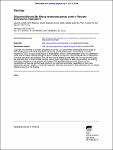




A large Oligocene-Miocene extensional gneiss dome in Vietnam has implications for the kinematics of the Ailao Shan Red River shear zone and rifting of the South China Sea. A major northeast-dipping extensional shear zone separates the Bu Khang dome from less-metamorphosed units above. Shearing deformation occurred during the exhumation of high-pressure rocks. 40Ar-39Ar ages on micas reveal Oligocene-Miocene ages, from 36 to 21 Ma. After a high-pressure episode of probable Oligocene age, the area was subjected to northeast-southwest extension during the opening of the South China Sea. A kinematic model involving left-lateral shear and block rotation within a north-south dextral shear zone integrates our observations in the Bu Khang dome with South China Sea rifting.
Readership Map
Content Distribution


A large Oligocene-Miocene extensional gneiss dome in Vietnam has implications for the kinematics of the Ailao Shan Red River shear zone and rifting of the South China Sea. A major northeast-dipping extensional shear zone separates the Bu Khang dome from less-metamorphosed units above. Shearing deformation occurred during the exhumation of high-pressure rocks. 40Ar-39Ar ages on micas reveal Oligocene-Miocene ages, from 36 to 21 Ma. After a high-pressure episode of probable Oligocene age, the area was subjected to northeast-southwest extension during the opening of the South China Sea. A kinematic model involving left-lateral shear and block rotation within a north-south dextral shear zone integrates our observations in the Bu Khang dome with South China Sea rifting.